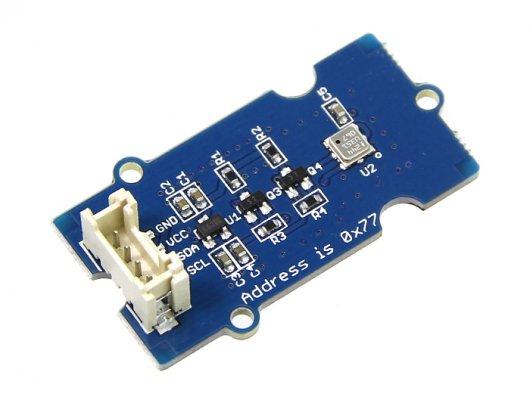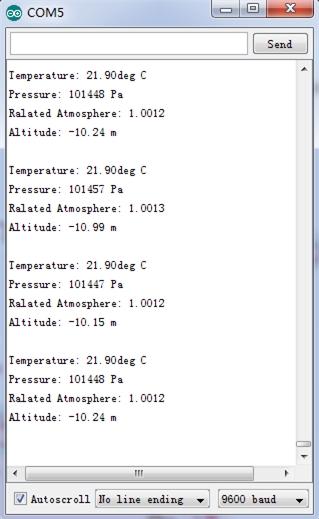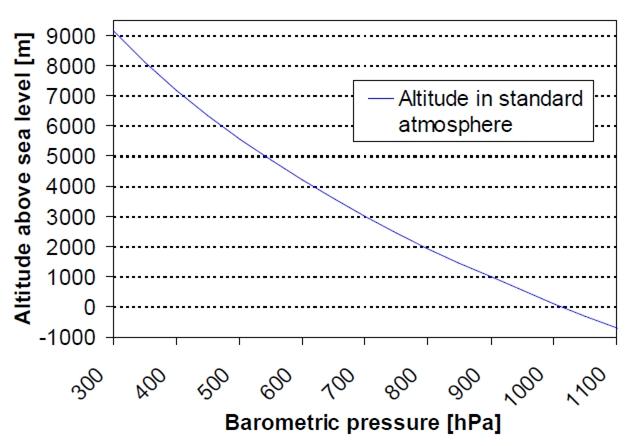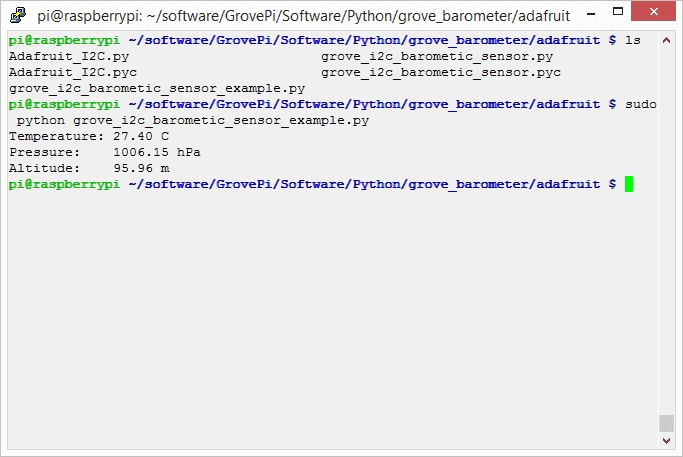Grove Barometer Sensor BMP180

This is a Grove module for the Bosch BMP180 high-precision, low-power digital barometer. The BMP180 offers a pressure measuring range of 300 to 1100 hPa with an accuracy down to 0.02 hPa in advanced resolution mode. It’s based on piezo-resistive technology for high accuracy, ruggedness and long term stability. The chip only accepts 1.8V to 3.6V input voltage. However, with outer circuit added, this module becomes compatible with 3.3V and 5V. Therefore, it can be used on Arduino/Seeeduino or Seeeduino Stalker without modification.It is designed to be connected directly to a micro-controller via the I2C bus.
[![]() ](http://www.seeedstudio.com/Grove-Barometer-Sensor-(BMP180)-p-1840.html)
](http://www.seeedstudio.com/Grove-Barometer-Sensor-(BMP180)-p-1840.html)
Features
Digital two wire (I2C) interface
Wide barometric pressure range
Flexible supply voltage range
Ultra-low power consumption
Low noise measurement
Factory-calibrated
-40 to +85°C operational range, ±2°C temperature accuracy
I2C address: 0x77
!!!Tip More details about Grove modules please refer to Grove System
Application Ideas
Enhancement of GPS navigation
Indoor and outdoor navigation
Leisure and sports
Weather forecast
Vertical velocity indication (rise/sink speed)
Specifications
Item
Min
Typical
Max
Unit
Voltage
3
5
5.5
VDC
Current
1.1
/
20
uA
Pressure Range
300
/
1100
hPa
Faster I2C data transfer
/
/
3.4
MHZ
Dimension
40.1*20.2*9.7
mm
Platforms Supported
Usage
With Arduino
Barometric condition is one of the criteria used to predict coming change in weather and deduce altitude above sea level. Here is a demo to show you how to read the barometric data from this Grove - Barometer Sensor (BMP180).
1.Connect it to IIC port of Seeeduino or Grove - Base Shield via a Grove cable. And connect Arduino to PC via a USB cable.
2.Download the library(the barometer library is shared by Grove - Barometer Sensor (BMP180) and Grove - Barometer Sensor(BMP085));Unzip it into the libraries file of Arduino IDE by the path: ..\arduino-1.0.1\libraries.
3.Create a new Arduino sketch and paste the codes below to it or open the code directly by the path:File -> Example ->Barometer_Sensor->Barometer_Sensor.
4.Open the serial monitor to receive the sensor's data including temperature, barometric pressure value, relative atmosphere pressure and altitude.

The following is a reference graph plotting out the relationship between altitude above sea level and barometric pressure.

With Raspberry Pi
1.You should have got a raspberry pi and a grovepi or grovepi+.
2.You should have completed configuring the development enviroment, otherwise follow here.
3.Connection
Plug the sensor to grovepi socket i2c-x(1~3) by using a grove cable.
4.Navigate to the demos' directory:
To see the code
5.Run the demo.
6.Result

Resources
Last updated
Was this helpful?